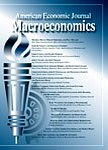-
作者:Aruoba, S. Boragan; Schorfheide, Frank
作者单位:University System of Maryland; University of Maryland College Park; University of Pennsylvania
摘要:We develop a two-sector monetary model with a centralized and decentralized market. Activities in the centralized market resemble those in a standard New Keynesian economy with price rigidities. In the decentralized market agents engage in bilateral exchanges for which money is essential. This paper is the first to formally estimate such a model, evaluate its fit based on postwar US data, and assess its money demand properties. Steady-state welfare calculations reveal that the distortions crea...
-
作者:Bils, Mark; Chang, Yongsung; Kim, Sun-Bin
作者单位:University of Rochester; Yonsei University
摘要:We model worker heterogeneity in the rents from being employed in a Diamond-Mortensen-Pissarides model of matching and unemployment. We show that heterogeneity, reflecting differences in match quality and worker assets, reduces the extent of fluctuations in separations and unemployment. We find that the model faces a trade-off it cannot produce both realistic dispersion in wage growth across workers and realistic cyclical fluctuations in unemployment. (JEL D31, E24, E32, J41, J63)
-
作者:Woodford, Michael
作者单位:Columbia University
摘要:This paper explains the key factors that determine the output multiplier of government purchases in New Keynesian models, through a series of simple examples that can be solved analytically. Sticky prices or wages allow for larger multipliers than in a neoclassical model, though the size of the multiplier depends crucially on the monetary policy response. A multiplier well in excess of one is possible when monetary policy is constrained by the zero lower bound, and in this case welfare increas...
-
作者:Krane, Spencer D.
作者单位:Federal Reserve System - USA; Federal Reserve Bank - Chicago
摘要:This paper examines how the professional forecasters comprising the Blue Chip Economic Consensus view shocks to GDP. I use an unobserved components model of the forecast revisions to identify forecasters' perceptions of permanent and transitory shocks to GDP The model indicates forecasters: attribute about two-thirds of the variance in current-period revisions to permanent shocks; view the relative importance of permanent shocks similar to the estimates of some simple univariate econometric mo...


